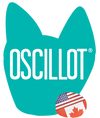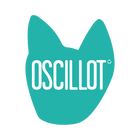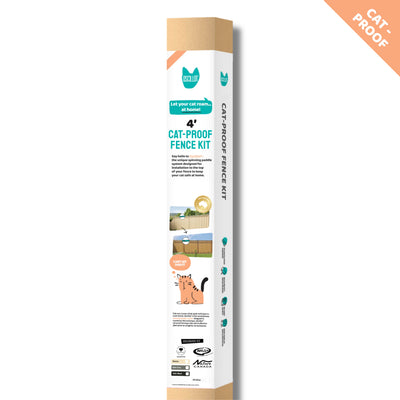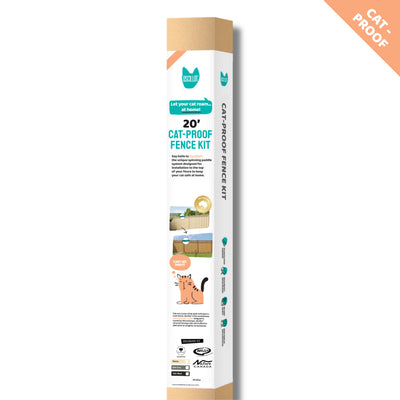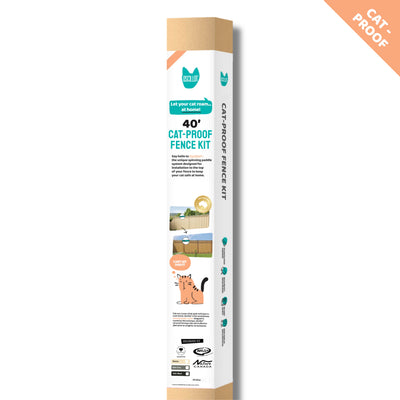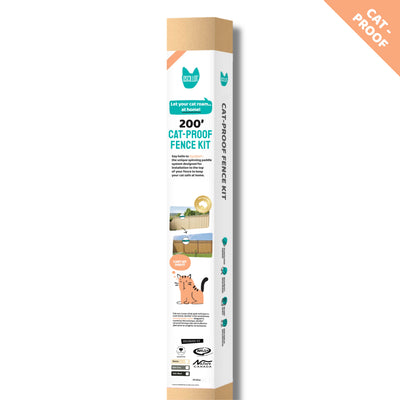The Economics of Cat Ownership: How Cat Fencing Reduces Vet Bills

The Economics of Cat Ownership: How Cat Fencing Reduces Vet Bills
A Comprehensive ROI Analysis of Investing in Cat-Proof Fencing Systems
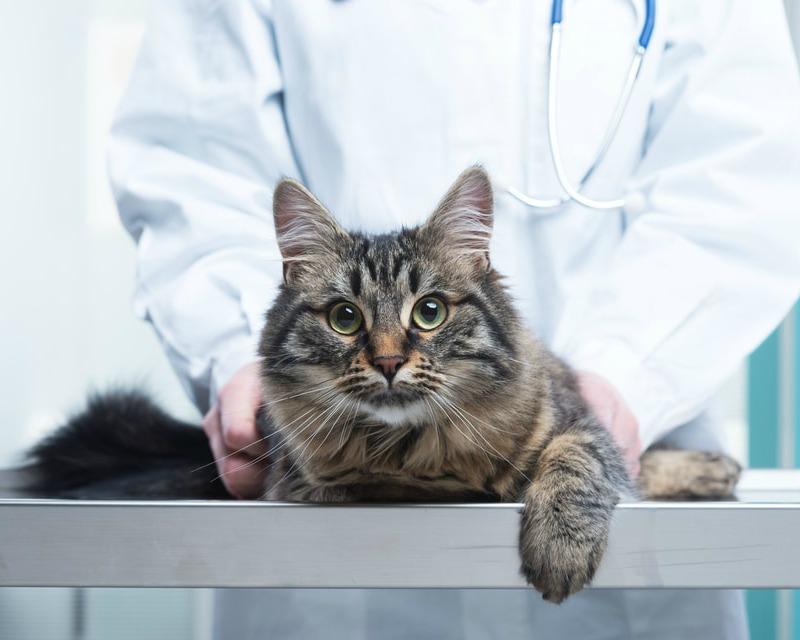
As a cat owner, you want the best for your feline companion. You want them to enjoy the outdoors, experience fresh air, and explore their natural instincts. However, the hidden costs of allowing cats unrestricted outdoor access can be staggering. This comprehensive analysis reveals how investing in a cat-proof fencing system like Oscillot can save you thousands of dollars in veterinary bills over your cat's lifetime while keeping your beloved pet safe and healthy.
The True Cost of Cat Ownership: What the Numbers Tell Us
Understanding the financial commitment of cat ownership begins with examining the real costs that pet parents face annually. According to recent veterinary industry data, cat ownership involves significant ongoing expenses that many new pet owners underestimate.
These baseline costs represent routine care for healthy cats. However, the financial picture changes dramatically when we examine the elevated risks and expenses associated with outdoor cats. The American Veterinary Medical Association reports that households with cats spent approximately $433 annually on veterinary care in 2024, but this figure represents an average across all cats—both indoor and outdoor.
The Indoor vs. Outdoor Cat Cost Differential
The distinction between indoor and outdoor cats creates a significant cost disparity that every cat owner should understand. Outdoor cats face substantially higher risks, which directly translate to increased veterinary expenses:
Additional Annual Costs for Outdoor Cats
| Expense Category | Annual Cost | Description |
|---|---|---|
| Preventative Medications | $200-$300 | Heartworm and flea/tick preventatives |
| Additional Testing | $50-$150 | Disease screening and parasite checks |
| Extra Vaccinations | $60-$100 | FeLV, FIV, and other outdoor-specific vaccines |
| Total Additional Cost | $310-$550 | Annual preventative care premium |
This additional $310-$550 in annual preventative care represents only the predictable costs. The truly devastating expenses come from emergency situations and injuries—costs that can arise unexpectedly and create financial hardship for unprepared pet owners.
The Hidden Dangers: What Outdoor Cats Face Daily
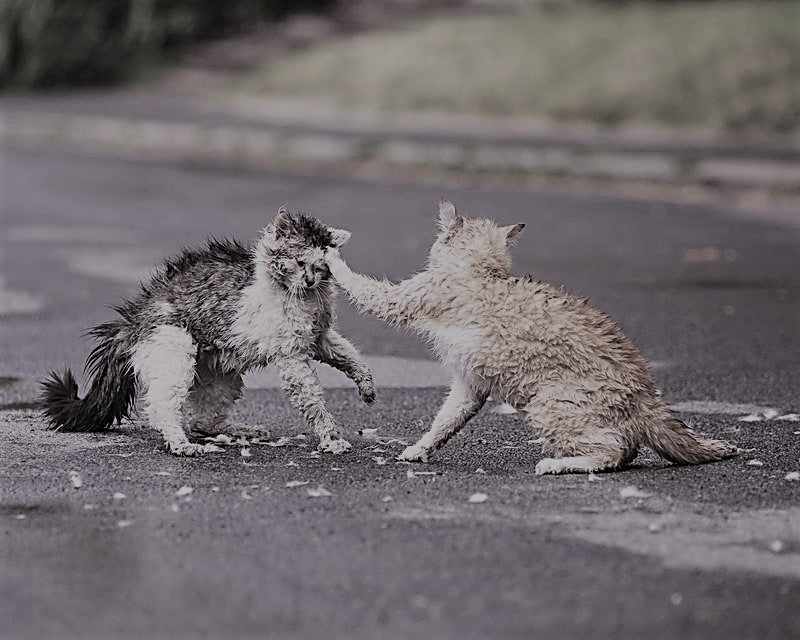
Every time an outdoor cat ventures beyond the safety of your home, they enter an environment filled with potential hazards. Understanding these risks is crucial for appreciating the protective value of cat-proof fencing systems.
Traffic Accidents: The Leading Cause of Outdoor Cat Fatalities
The Bristol Cats Study revealed shocking statistics about feline traffic accidents. Of all road traffic incidents involving cats, 74.5% proved fatal at the scene, while 17% resulted in non-fatal injuries requiring immediate veterinary intervention. These surviving cats often face extensive medical procedures:
Traffic Accident Treatment Costs
| Treatment Type | Cost Range | Common Procedures |
|---|---|---|
| Emergency Room Visit | $200-$1,500 | Initial assessment, stabilization, diagnostics |
| Fracture Repair Surgery | $1,500-$4,000 | Bone setting, pins, plates, post-op care |
| Internal Injury Treatment | $2,000-$7,000 | Surgery, organ repair, blood transfusions |
| Hospitalization (3-7 days) | $600-$2,500 | Post-surgical monitoring and care |
| Physical Therapy | $400-$1,200 | Rehabilitation for mobility restoration |
Animal Attacks and Territorial Conflicts
Territorial disputes with other cats, attacks from dogs, and predation by wildlife represent another major category of outdoor cat injuries. These encounters frequently result in bite wounds, scratches, and secondary infections that require immediate medical attention.
- Cat Fight Injuries: Bite wounds from other cats commonly develop into painful abscesses requiring drainage, antibiotics, and pain management. Treatment costs range from $400-$800 per incident.
- Dog Attacks: Injuries from dog encounters often involve extensive soft tissue damage, requiring wound repair, antibiotics, and sometimes reconstructive surgery. Costs typically range from $800-$3,000.
- Wildlife Encounters: Confrontations with raccoons, foxes, coyotes, or predatory birds can result in severe trauma requiring emergency surgery and extended hospitalization, with costs reaching $2,000-$5,000.
Wound Treatment and Infection Costs
| Injury Type | Initial Treatment | Complications | Total Cost Range |
|---|---|---|---|
| Simple Abscess | $250-$500 | $300-$500 (if infected) | $400-$1,000 |
| Deep Bite Wounds | $500-$1,200 | $600-$1,500 (sepsis risk) | $800-$2,700 |
| Severe Lacerations | $800-$1,800 | $400-$800 (reconstructive) | $1,200-$2,600 |
| Puncture Wounds (internal) | $1,000-$2,500 | $1,500-$3,500 (organ damage) | $2,500-$6,000 |
Infectious Diseases: The Silent Cost Multiplier
Outdoor cats face constant exposure to infectious diseases transmitted through contact with other cats, contaminated environments, or infected prey. These diseases often require lifelong management and create recurring veterinary expenses.
Common Outdoor Cat Diseases and Treatment Costs
| Disease | Initial Diagnosis | Annual Management | Lifetime Cost |
|---|---|---|---|
| Feline Leukemia Virus (FeLV) | $150-$400 | $500-$1,200 | $5,000-$15,000 |
| Feline Immunodeficiency Virus (FIV) | $150-$400 | $600-$1,500 | $6,000-$18,000 |
| Feline Infectious Peritonitis | $200-$600 | $2,000-$5,000 | $10,000-$30,000 |
| Upper Respiratory Infections | $100-$300 | $200-$600 | $2,000-$8,000 |
| Parasitic Infections | $80-$250 | $150-$400 | $1,500-$5,000 |
The Lifespan Economics: Indoor vs. Outdoor Cats
Perhaps the most striking economic difference between indoor and outdoor cats appears in their life expectancy and associated lifetime costs.
While indoor cats enjoy dramatically longer lifespans, the economic implications extend beyond simple longevity. Let's examine the total cost of ownership under different scenarios:
Lifetime Cost Comparison: Indoor vs. Outdoor Cats
| Cost Category | Indoor Cat (15 years) | Outdoor Cat (4 years) | Outdoor Cat (15 years if survived) |
|---|---|---|---|
| Routine Vet Care | $6,495 | $1,732 | $6,495 |
| Preventative Medications | $1,500 | $1,200 | $4,500 |
| Emergency Care (average) | $800 | $3,200 | $12,000 |
| Disease Treatment | $1,200 | $2,400 | $9,000 |
| Injury Treatment | $400 | $2,800 | $10,500 |
| Total Veterinary Costs | $10,395 | $11,332 | $42,495 |
| Annual Average | $693/year | $2,833/year | $2,833/year |
This comparison reveals a crucial economic reality: outdoor cats face approximately 300% higher annual veterinary costs compared to protected indoor cats. Even more significantly, the shortened lifespan means that outdoor cat owners experience compressed costs—paying similar total amounts over dramatically fewer years, while also losing many years of companionship with their pets.
Pet Insurance: Understanding the Outdoor Cat Premium
Many cat owners consider pet insurance to manage unexpected veterinary expenses. However, insurance companies recognize the elevated risks of outdoor cats and price their policies accordingly.
Insurance for outdoor cats typically costs 25-40% more than coverage for indoor-only cats, reflecting the statistical reality of their increased injury and illness rates. Over a cat's lifetime, this premium difference can amount to $1,500-$2,500—costs that could instead fund a comprehensive Oscillot fence system.
The Oscillot Solution: Cat-Proof Fencing That Pays for Itself
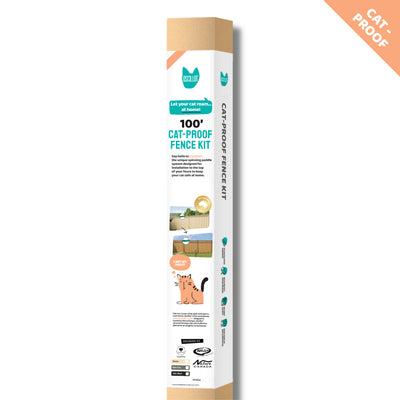
Oscillot represents a revolutionary approach to cat containment—a one-time investment that provides lifetime protection and delivers substantial return on investment through reduced veterinary expenses.
How Oscillot Works: The Science of Cat-Proof Protection
The Oscillot system employs an ingeniously simple mechanical principle. Paddle-shaped components mounted atop existing fences rotate freely when touched. When a cat attempts to scale the fence and places a paw on an Oscillot paddle, the rotation prevents the cat from gaining traction, causing them to safely return to the ground. This passive system requires no electricity, produces no harm to the cat, and operates continuously without maintenance.
- Rust-Proof Construction: Marine-grade aluminum paddles withstand all weather conditions
- Universal Compatibility: Installs on wood, vinyl, masonry, chain-link, and composite fences
- DIY Installation: Most homeowners complete installation in just a few hours using basic tools
- Humane Design: Completely safe for cats—no electricity, no sharp edges, no traps
- Maintenance-Free: Once installed, the system requires virtually no ongoing maintenance
- Aesthetic Appeal: Low-profile design complements existing fencing without creating an institutional appearance
Complete Product Range: Solutions for Every Property
Oscillot offers comprehensive kit sizes to accommodate properties of all dimensions, from small urban yards to expansive suburban estates. Each kit includes all necessary components for installation on standard 6-foot fencing.
ROI Analysis: The Five-Year Savings Breakdown
Comprehensive Return on Investment Calculation
Let's examine the economic impact of Oscillot installation for a typical homeowner with a 100-foot perimeter backyard fence protecting one outdoor cat over a five-year period.
Initial Investment Analysis
| Component | Cost | Notes |
|---|---|---|
| 100' Oscillot Kit | $710 | One-time purchase, lifetime protection |
| Installation Tools (if needed) | $0-$50 | Most homeowners own necessary tools |
| Professional Installation (optional) | $0-$300 | DIY saves significant costs |
| Annual Maintenance | $0 | Maintenance-free system |
| Total Investment (DIY) | $710-$760 | One-time expense |
Five-Year Cost Comparison: Protected vs. Unprotected Outdoor Cat
| Expense Category | Unprotected Outdoor Cat | Oscillot-Protected Cat | Savings |
|---|---|---|---|
| Routine Vet Visits (5 years) | $2,165 | $2,165 | $0 |
| Outdoor Preventatives (5 years) | $1,500 | $750 | $750 |
| Additional Vaccines/Testing | $400 | $200 | $200 |
| Emergency Care (average incidents) | $4,200 | $500 | $3,700 |
| Injury Treatment | $2,800 | $300 | $2,500 |
| Disease Treatment (preventable) | $1,800 | $400 | $1,400 |
| Pet Insurance Premiums | $2,400 | $1,800 | $600 |
| Insurance Deductibles/Co-pays | $1,200 | $200 | $1,000 |
| Total 5-Year Costs | $16,465 | $6,315 | $10,150 |
| Oscillot Investment | - | $710 | - |
| Net 5-Year Position | ($16,465) | ($7,025) | $9,440 |
ROI Summary: The Numbers Speak for Themselves
Long-Term Economic Benefits: The 15-Year Perspective
The economic advantages of Oscillot installation compound dramatically over your cat's lifetime. Let's examine the full 15-year scenario, representing the average lifespan of a well-protected indoor cat:
Lifetime (15-Year) Financial Comparison
| Category | Unprotected Outdoor Cat | Oscillot-Protected Cat | Lifetime Savings |
|---|---|---|---|
| Total Veterinary Costs | $42,495 | $12,395 | $30,100 |
| Pet Insurance (15 years) | $7,200 | $5,400 | $1,800 |
| Oscillot System | $0 | $710 | -$710 |
| Net Lifetime Cost | $49,695 | $18,505 | $31,190 |
| Note: This assumes the outdoor cat survives 15 years, which is statistically unlikely given the 2-5 year average lifespan. | |||
Lifetime Value Proposition
Investing $710 in an Oscillot cat fence system generates an average lifetime savings of $31,190—a return of over 4,300%. More importantly, this investment dramatically increases the likelihood that your cat will actually reach their 15-year life expectancy, rather than succumbing to outdoor hazards within 2-5 years.
The emotional value of 10-13 additional years with your beloved companion is incalculable, but the financial case alone demonstrates the wisdom of this investment.
Beyond Veterinary Savings: Additional Economic Benefits
While reduced veterinary expenses represent the primary financial benefit of Oscillot installation, cat owners experience numerous additional economic advantages:
Property Protection and Reduced Damage
- Garden Preservation: Contained cats cannot damage neighbor's gardens, eliminating potential liability for property damage and maintaining positive community relationships
- Wildlife Protection: Prevention of wildlife hunting eliminates potential fines in areas with wildlife protection ordinances (fines can reach $500-$2,000)
- Reduced Neighbor Conflicts: Avoiding disputes over cats using neighbor's property as litter boxes or hunting grounds prevents potential legal costs
- Car Damage Prevention: Contained cats won't scratch paint or leave paw prints on neighbor's vehicles, avoiding damage claims
Emotional and Psychological Value
While difficult to quantify financially, the peace of mind provided by Oscillot installation delivers substantial life-quality improvements:
- Stress Reduction: Eliminating constant worry about your cat's whereabouts and safety improves daily quality of life
- Sleep Quality: No more sleepless nights wondering if your cat will return home safely
- Work Productivity: Reduced anxiety during work hours when you would otherwise worry about outdoor dangers
- Family Harmony: Children especially benefit from knowing their beloved pet is safe and protected
Time Savings and Convenience
Protected cats require less intensive monitoring and supervision:
- Reduced Search Time: No more hours spent searching the neighborhood for missing cats
- Fewer Emergency Vet Visits: Eliminating emergency situations saves time in addition to money
- Simplified Travel Planning: Easier to arrange cat care when the cat is safely contained in your yard
- Lower Monitoring Requirements: Less need to constantly check on your cat's location and activities
Comparing Containment Solutions: Why Oscillot Offers Superior Value
Cat owners considering containment solutions face multiple options, each with distinct economic implications:
Containment Solution Cost Comparison
| Solution | Initial Cost | Installation | Annual Maintenance | 5-Year Total | Effectiveness |
|---|---|---|---|---|---|
| Oscillot (100') | $710 | DIY (4-6 hours) | $0 | $710 | 99%+ |
| Traditional Catio | $2,000-$5,000 | Professional required | $50-$200 | $2,250-$6,000 | 100% (limited space) |
| Invisible Fence | $1,000-$2,500 | Professional required | $100-$300 | $1,500-$4,000 | 60-70% |
| Netting Systems | $500-$1,500 | DIY or Professional | $100-$300 | $1,000-$3,000 | 70-80% |
| Full Fence Replacement | $3,000-$8,000 | Professional required | $50-$150 | $3,250-$8,750 | 95%+ |
Oscillot provides the optimal balance of effectiveness, affordability, and ease of installation. Unlike catios that restrict outdoor access to small enclosed spaces, Oscillot allows cats to enjoy their entire yard. Unlike invisible fences that deliver uncomfortable shocks and prove ineffective for determined cats, Oscillot operates through gentle, passive mechanical prevention. Unlike netting that deteriorates and requires replacement, Oscillot's rust-proof aluminum construction provides decades of maintenance-free service.
Case Studies: Real-World ROI Examples
Case Study 1: The Johnson Family - Suburban Home, Two Cats
"Before installing Oscillot on our 120-foot fence perimeter, we averaged 2-3 emergency vet visits annually between our two cats. Fight wounds, a car accident scare, and a mysterious illness cost us over $4,800 in one year alone. Our Oscillot installation cost $852, and in the three years since, we've had zero emergency visits. The system paid for itself in less than two months, and we've saved an estimated $13,500 over three years. More importantly, our cats are safe, happy, and still enjoying outdoor time in our yard."
— Sarah Johnson, Denver, CO
Case Study 2: The Martinez Household - Urban Property, One Cat
"Living in the city, our cat Felix faced constant dangers—traffic, other animals, and even potential theft. After a $2,200 emergency surgery for a bite wound abscess, we installed a 60-foot Oscillot system for $443. That was four years ago. Felix still goes outside daily but stays safely in our yard. Our vet bills dropped from averaging $1,800 annually to around $400 for routine care. The peace of mind alone is worth far more than we paid."
— Carlos Martinez, Portland, OR
Case Study 3: The Chen Family - Rural Property, Three Cats
"On our rural property, we worried about coyotes, cars on the nearby road, and our cats wandering into neighboring farms. We installed 200 feet of Oscillot for $1,351. In the first year alone, we avoided what would have been certain emergency costs based on our previous experience losing two cats to outdoor dangers. With three cats now safely contained, we estimate we're saving $3,000-$4,000 annually in veterinary costs and insurance premiums. The system transformed our relationship with our cats—no more anxiety, just enjoyment."
— Linda Chen, Sonoma, CA
Installation Economics: DIY vs. Professional
Oscillot's DIY-friendly design allows most homeowners to install the system themselves, maximizing economic benefits:
Installation Cost Analysis (100' Kit Example)
| Installation Method | Material Cost | Labor Cost | Time Investment | Total Cost |
|---|---|---|---|---|
| DIY Installation | $710 | $0 | 4-6 hours | $710 |
| Handyman Installation | $710 | $200-$400 | 2-3 hours | $910-$1,110 |
| Professional Contractor | $710 | $400-$600 | 2-4 hours | $1,110-$1,310 |
DIY installation maximizes your return on investment and requires only basic tools most homeowners already possess: a drill, level, measuring tape, and ladder. Detailed installation instructions and video tutorials guide you through each step. Even homeowners who choose professional installation still realize substantial savings compared to alternative containment solutions and the veterinary costs they prevent.
Required Tools and Materials
- Power drill with appropriate bits for your fence type
- Measuring tape and level for accurate placement
- Ladder for reaching fence tops (6-foot fences are standard)
- Pencil or marker for marking installation points
- Safety equipment: gloves and safety glasses
All mounting hardware and brackets come included with your Oscillot kit. The system works with virtually any fence type including wood, vinyl, masonry, chain-link, and composite materials.
Maximizing Your Investment: Best Practices for Oscillot Users
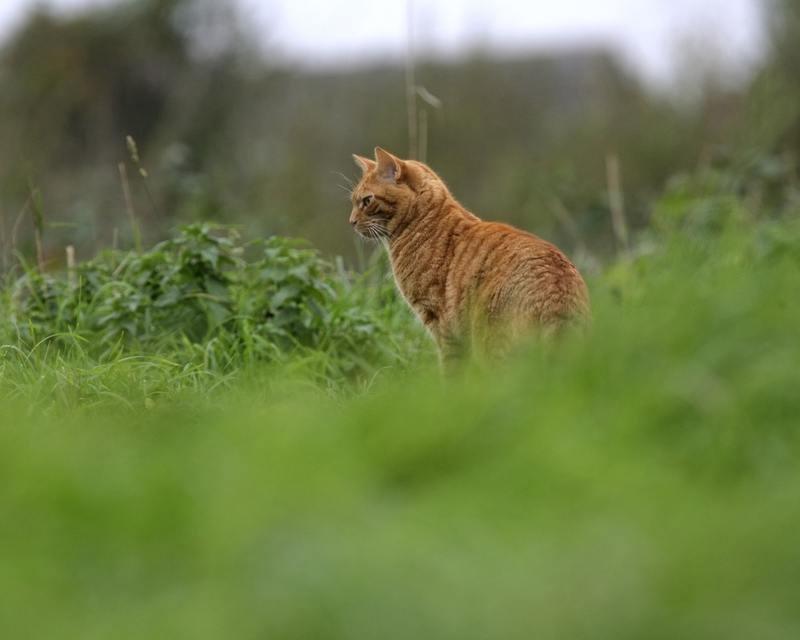
To ensure maximum return on your Oscillot investment, follow these proven practices:
Complete Perimeter Protection
For optimal effectiveness, install Oscillot around your entire yard perimeter. Gaps in coverage allow determined cats to find escape routes. When calculating your needs:
- Measure your complete fence perimeter, including gates
- Account for any changes in fence height or type
- Consider future yard modifications or additions
- Order slightly more than calculated to ensure complete coverage
Proper Installation Height
Oscillot works optimally on fences at least 6 feet tall. Lower fences may require additional modifications:
- For 4-5 foot fences, consider adding height extensions before Oscillot installation
- Ensure no nearby objects (trees, furniture, structures) provide jumping platforms
- Install Oscillot at the absolute top of the fence for maximum effectiveness
- Verify gate heights match fence heights to prevent escape routes
Regular Visual Inspections
While Oscillot requires no maintenance, periodic visual inspections ensure continued effectiveness:
- Every 3-6 months, walk your fence line to verify all paddles spin freely
- Remove any debris (leaves, branches) that might interfere with rotation
- Check mounting brackets remain secure, especially after severe weather
- Verify fence structural integrity to prevent indirect escape routes
Complementary Outdoor Safety Measures
Combine Oscillot with other safety practices for comprehensive protection:
- Maintain current vaccinations even for contained cats
- Provide engaging outdoor enrichment (cat grass, climbing structures, shaded areas)
- Ensure fresh water availability during outdoor time
- Create predator-resistant shelters for weather protection
- Consider microchipping as backup identification if escape ever occurs
Frequently Asked Questions: Economics and Value
Common Economic Questions Answered
Q: Is Oscillot really worth the investment for indoor cats who only occasionally go outside?
A: Absolutely. Even occasional outdoor access exposes cats to all the same risks—traffic, predators, diseases, and conflicts. A single emergency incident can cost several times the Oscillot investment. Additionally, once installed, Oscillot allows you to safely expand your cat's outdoor time, enriching their life without increasing risk.
Q: How does Oscillot compare financially to building a catio?
A: Traditional catios cost $2,000-$5,000 or more for professional installation and restrict cats to small enclosed spaces. Oscillot costs 75-90% less and allows cats to enjoy their entire yard. The economic advantage is overwhelming, especially considering that Oscillot prevents the same injuries and escapes at a fraction of the cost.
Q: Will my homeowner's insurance rates decrease with Oscillot installation?
A: While insurance policies vary, some homeowners have successfully argued for reduced liability premiums based on containing their pets and eliminating risks to neighbors' property. Contact your insurance provider to discuss potential discounts for responsible pet containment.
Q: What happens if I move to a new house?
A: Oscillot systems can be uninstalled and reinstalled at new properties, protecting your investment. Alternatively, leaving the system installed may increase property value for buyers with cats, providing another economic benefit. The portability ensures your investment remains valuable regardless of housing changes.
Q: Do I need to install Oscillot on shared fence lines with neighbors?
A: Yes, for complete protection. Installing only on fences you own creates gaps in coverage. Most neighbors appreciate the gesture of keeping your cats from entering their property. The complete perimeter installation ensures maximum veterinary cost savings by preventing all escape routes.
The Environmental and Ethical Economics
Beyond personal financial benefits, Oscillot installation delivers broader environmental and ethical value:
Wildlife Protection Value
Outdoor cats kill an estimated 2.4 billion birds and 12.3 billion small mammals annually in the United States alone. This ecological damage has economic consequences:
- Agricultural pest control disruption when cats kill beneficial predator species
- Ecosystem imbalance requiring expensive restoration efforts
- Endangered species recovery programs costing taxpayers millions
- Property damage from pest species when natural predators are eliminated
By containing your cat, you participate in broader environmental protection efforts with measurable economic and ecological value to your community.
Reduced Municipal Animal Control Costs
Roaming cats create substantial municipal expenses:
- Animal control officer time responding to complaints
- Shelter resources for stray or injured cats
- Veterinary services for injured strays
- Population control programs addressing feral cat issues
These costs get passed to taxpayers. Responsible cat containment reduces community burden and demonstrates civic responsibility.
Making the Investment Decision: Is Oscillot Right for You?
Consider Oscillot installation if any of these situations apply to your household:
Ideal Candidate Checklist
- You currently allow your cat outdoor access or are considering it
- You've experienced emergency veterinary costs from outdoor incidents
- You worry about your cat's safety when they're outside
- You want to reduce ongoing veterinary and insurance expenses
- You have adequate fence height (6 feet minimum) or can add height extensions
- You want a maintenance-free, long-term containment solution
- You value both financial savings and peace of mind
- You're concerned about environmental impact of outdoor cats
- You want to be a responsible neighbor and community member
- You're seeking the best return on investment for pet safety
Taking Action: Your Path to Savings and Safety
Ready to protect your cat and your finances? Follow these steps to begin your Oscillot journey:
Step 1: Measure Your Perimeter
Walk your property fence line and measure the total linear feet requiring protection. Include all gates and fence sections where your cat might attempt escape. Add 10% to your measurement to ensure complete coverage and account for any measurement variations.
Step 2: Select Your Kit Size
Based on your measurements, choose the appropriate kit size or combination of kits. Remember that larger kits provide better per-foot value:
Choose from 4', 8', 12', 16', 20', or 40' kits
Optimal choices: 40', 60', 80', or 100' kits
Best value: 120', 200', or 300' kits
Step 3: Plan Your Installation
Decide whether you'll install the system yourself or hire assistance. DIY installation maximizes your savings and typically takes just one afternoon. Gather necessary tools and review installation instructions before beginning.
Step 4: Order Your System
Visit the Oscillot North America website to place your order. Select your preferred frame material and color options to match your existing fence aesthetics. Most orders ship quickly and include all necessary mounting hardware.
Step 5: Install and Enjoy
Follow the provided instructions for professional-quality installation. Most homeowners complete 100 feet of installation in 4-6 hours. Once installed, introduce your cat to their newly protected outdoor space and enjoy peace of mind knowing they're safe from outdoor dangers.
Your Investment Starts Paying Returns Immediately
From the moment your Oscillot system is installed, you begin accumulating savings through prevented emergency vet visits, reduced insurance premiums, eliminated injury treatments, and avoided disease exposure. Every day your cat safely enjoys outdoor time represents another day of return on your wise investment.
Conclusion: The Economics of Love and Responsibility
Investing in an Oscillot cat fence system represents one of the smartest financial decisions a cat owner can make. With a typical return on investment exceeding 1,300% over five years and 4,300% over a cat's lifetime, the economic case is irrefutable. But beyond the impressive financial returns lies something even more valuable: the priceless peace of mind that comes from knowing your beloved companion is safe, healthy, and able to enjoy outdoor enrichment without exposure to life-threatening dangers.
The average $710 investment in a 100-foot Oscillot system pales in comparison to the thousands—potentially tens of thousands—of dollars you'll save in emergency veterinary care, injury treatments, disease management, and insurance premiums. More importantly, you're investing in years of companionship with your cat, dramatically increasing the likelihood they'll reach their full 12-18 year life expectancy rather than falling victim to outdoor hazards within 2-5 years.
Every cat owner faces a choice: accept the substantial ongoing costs and constant anxiety of outdoor dangers, restrict your cat to indoor-only living, or make a one-time investment in proven protection that pays returns for your cat's entire lifetime. The data, the economics, and the experiences of thousands of satisfied Oscillot users point to a clear answer.
Your cat deserves the freedom to explore, the fresh air and sunshine they crave, and the mental stimulation that outdoor time provides. You deserve financial security, peace of mind, and confidence that your investment in your cat's safety delivers exceptional returns. Oscillot provides both, combining superior protection with unmatched economic value.
Ready to Protect Your Cat and Your Wallet?
Explore the complete range of Oscillot cat-proof fence kits and find the perfect solution for your property. With sizes from 4 feet to 300 feet and prices starting at just $42, there's an Oscillot system for every yard and every budget.
Shop Oscillot Systems NowRemember: Every day you wait to install Oscillot is another day your cat faces preventable dangers and you risk substantial emergency veterinary expenses. The best time to invest in cat safety was yesterday. The second-best time is today. Make the decision that protects both your cat and your finances—invest in Oscillot and start enjoying returns immediately.
